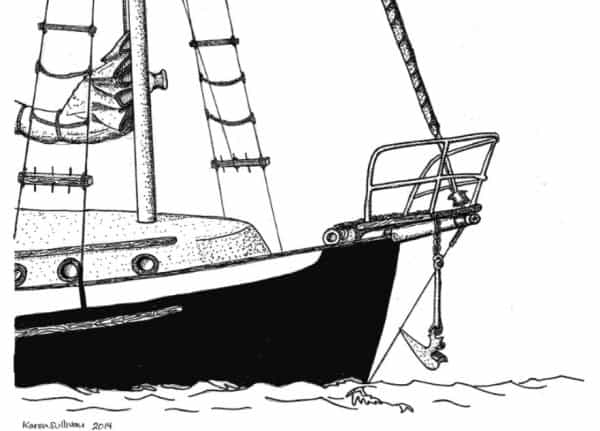This is an article from Good Old Boat (a magazine we like a lot), written by OCH Guide Karen Sullivan. Good Old Boat and Karen have graciously allowed us to republish it for OCH members.
No matter how you anchor, the basics are the same: have your ground tackle ready for instant use, choose your anchorage with care, and visualize your boat spaced evenly among the neighboring ones while riding along the perimeter of a circle drawn by your rode as its radius. Good ground tackle and knowing how to use it are your boat’s best insurance policy. Two properly sized anchors and enough chain, marked rode, and chafe gear are the minimum for a cruising boat. I’ve rarely had to use more than two anchors, but when I did, it was mighty good to have them.
When choosing a spot in a crowded anchorage, it sometimes works to drop your hook just astern of and a few yards to one side of the boat that will be lying to windward of you. That will allow you full use of your swinging room. Be sure to note whether other boats are using all-chain rodes or a combination of chain and rope, and try to anchor nearer to boats of similar size to yours that are using similar ground tackle. A large, full-keel boat on all chain will swing differently from a small, fin-keeled boat on a combination rode.

It’s discourteous to anchor too near another boat if there’s room elsewhere, so when given the chance, I always anchor as far from other boats s possible. That way, if the wind shifts or pipes up, I can let out more rode without crowding anyone. A parking-lot mentality pervades some harbors when boats anchor practically atop one another, but you’re less likely to have problems if you stay away from the crowd — even if it means moving to another spot because someone’s crowded you. Pay attention to the weather forecast and perhaps choose a less crowded anchorage if the sky looks threatening.
. . . sign up to the right to get immediate access to this full post,
plus you'll get 10 of our best videos for free.
Get Free Videos& Learn More Join Now!!for Full Access Members Sign In


David Tew says:
Always good to review useful anchoring techniques when each cruising season approaches. Maynard Bray has offered more advisory OCH videos about anchoring here: https://www.offcenterharbor.com/videos/anchor-boat-part-1-anchoring-small-powerboat-yachtsman/
Kurt Lorenz says:
If your boat, like mine, suffers from “sailing” on the anchor, back and forth side to side on bare poles. Try a kellet on the anchor rode. Adding some weight to the chain or rode so that the arc down and out to the anchor has an “elbow” in it seems to help sailing at anchor.
Tom McFarling says:
What is a Kellet?
Matthijs Siljee says:
A weight, attached to a light line, which you lower roved over your anchor rode, till about mid-length. It greatly increases the shock-damping, but also reduces the swing radius under normal wind/current loads. Some are made proprietary, 2-lobed and look like saddle-bags.
Greg Mactye says:
One of the best articles on this subject which I’ve read in quite some time. Welll done.
David Lindley says:
When I was sailing, I’m 84 and somewhat handicapped now, if there was room, I would sail down wind under the mainsail and gybe over my anchor point. When the boat lost way, the anchor was tripped and the rode payed out as she made stern way. The rode and chain were coiled down and tied off to the pulpit at four points with slippery hitches. When getting ready to anchor it was easy to jerk the hitches lose. The bitter end of the rode was tied to the mast with a bowline so there was no danger of ever losing the gear overboard. This gybing maneuver is handy when picking up a mooring or a man overboard. One boat I cruised on was a yawl with a fully battened mizzen. We kept the sail set all the time and it kept her head to wind whether moored to a buoy or at anchor.
jamie thomson says:
Interesting David.
Do you mean you gybed and headed into the wind, as kind of a quick stop?
David Tew says:
Very thorough treatment of the subject!